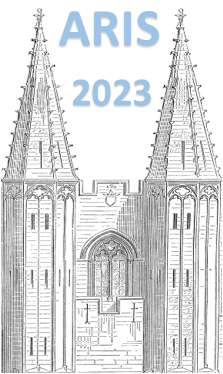Christine Hornung
(GSI Helmholtzzentrum für Schwerionenforschung)
Approaching the limits of nuclear binding, the structure and properties of drip-line nuclei is of great interest and draws a lot of attention from both, experiment and theory. The nuclear properties in the light lanthanide region are shaped by the interplay between large beta-decay Q-values, low or negative proton separation energies, and the confining effects of the Coulomb barrier. From precise mass values, differential quantities, such as the proton and neutron separation energies, can be determined, and different phenomena, including a variety of beta-delayed particle emission channels, proton radioactivity, and two-proton radioactivity as well as exotic pairing phenomena, can be addressed.
Nuclei in the region of between $^{100}$Sn and $^{150}$Lu were produced at relativistic energies and separated in-flight with the fragment separator FRS at GSI as part of the FAIR Phase-0 experiments. They were identified by their proton number and mass-to-charge ratio in the FRS, before being slowed down, thermalized in the Cryogenic Stopping Cell (CSC) of the FRS Ion Catcher and transported to a Multiple-Reflection Time-Of-Flight Mass Spectrometer (MR-TOF-MS) for high-resolution mass measurements. In order to calibrate and verify the particle identification at the FRS, a novel method, tagging by high resolution mass spectrometry using the MR-TOF-MS of the FRS Ion Catcher, was successfully applied.
In the experiment, new isotopes towards the proton drip-line, in the region between Nd and Tb, could be identified by the FRS particle identification. For the mass measurements a new technical approach was applied, the so called mean range bunching. The combination of achromatic ion optics of the FRS with a new variable wedge-shaped degrader system at the final focal plane allows to “correct” the range-position dependence, which enables efficient stopping of many nuclides in the CSC simultaneously. This novel technical approach was proven by the simultaneous measurement of more than 35 nuclides in a single setting. It opens up the possibility to cover large regions on the chart of the nuclides in a single measurement with stopped or thermalized nuclides, aside from mass measurements also for decay and laser spectroscopy. The masses of more than 10 nuclides were measured for the first time, and the mass uncertainties of more than 10 nuclides were significantly reduced. These results give an insight into the nuclear structure and for the first time allow tracking of the proton drip line between $^{100}$Sn and $^{150}$Lu. In this contribution, these recent results and the new technical approaches will be reported.
Christine Hornung
(GSI Helmholtzzentrum für Schwerionenforschung)
Daler Amanbayev
(Justus-Liebig-Universität Gießen)
Samuel Ayet San Andrés
(GSI Helmholtzzentrum für Schwerionenforschung, Justus-Liebig-Universität Gießen, Gießen)
Soumya Bagchi
(GSI Helmholtzzentrum für Schwerionenforschung, Indian Institute of Technology (Indian School of Mines), Jharkhand, Saint Mary’s University, Halifax)
Sönke Beck
(GSI Helmholtzzentrum für Schwerionenforschung, Justus-Liebig-Universität Gießen)
Prof.
Dimiter Balabanski
(ELI-NP, IFIN-HH)
Julian Bergmann
(Justus-Liebig-Universität Gießen)
Ziga Brencic
(Jozef Stefan Institute, Ljubljana)
Paul Constantin
(Extreme Light Infrastructure-Nuclear Physics (ELI-NP), Bucharest-Magurele)
Masoumeh Dehghan
(GSI Helmholtzzentrum für Schwerionenforschung)
Timo Dickel
(GSI Helmholtzzentrum für Schwerionenforschung)
Tayemar Fowler-Davis
(University of Edinburgh)
Hans GEISSEL
(GSI)
Florian Greiner
(GSI Helmholtzzentrum für Schwerionenforschung)
Lizzy Gröf
(Justus-Liebig-Universität Gießen)
Emma Haettner
(GSI Helmholtzzentrum für Schwerionenforschung)
Oscar Hall
(University of Edinburgh)
Muhsin N. Harakeh
(GSI/KVI)
Jan-Paul Hucka
(GSI Helmholtzzentrum für Schwerionenforschung, Technische Universität Darmstadt)
Nasser Kalantar-Nayestanaki
(Nuclear Energy Group, ESRIG, University of Groningen)
Anu Kankainen
(University of Jyväskylä)
Daria A. Kostyleva
(GSI Helmholtzzentrum für Schwerionenforschung,Justus-Liebig-Universität Gießen)
Gabriella Kripko-Koncz
(Justus-Liebig-Universität Gießen)
Erich Leistenschneider
(National Superconducting Cyclotron Laboratory, East Lansing)
Isreal Mardor
(Tel Aviv University, Soreq Nuclear Research Center, Yavne)
Nikolay Minkov
(Institute of Nuclear Research and Nuclear Energy, Bulgarian Academy of Sciences)
Ivan Miskun
(Justus-Liebig-Universität Gießen)
Ali Mollaebrahimi
(GSI Helmholtzzentrum für Schwerionenforschung, Justus-Liebig-Universität Gießen)
Ivan Mukha
(GSI Helmholtzzentrum für Schwerionenforschung)
Gottfried Münzenberg
(GSI Helmholtzzentrum für Schwerionenforschung)
Stephane Pietri
(GSI Helmholtzzentrum für Schwerionenforschung)
Wolfgang R. Plass
(GSI Helmholtzzentrum für Schwerionenforschung, Justus-Liebig-Universität Gießen)
Christophe Rappold
(GSI Helmholtzzentrum für Schwerionenforschung)
Moritz Pascal Reiter
(University of Edinburgh)
Heidi Roesch
(GSI Helmholtzzentrum für Schwerionenforschung,Technische Universität Darmstadt)
Christoph Scheidenberger
(GSI Helmholtzzentrum für Schwerionenforschung, Justus-Liebig-Universität Gießen)
Anamaria Spataru
(Extreme Light Infrastructure-Nuclear Physics (ELI-NP), Bucharest-Magurele)
Suraj Kumar Singh
(GSI Helmholtzzentrum für Schwerionenforschung, Justus-Liebig-Universität Gießen)
Yoshiki K. Tanaka
(High Energy Nuclear Physics Laboratory, RIKEN, Wako)
Matjaz Vencelj
(Jozef Stefan Institute, Ljubljana)
Helmut Weick
(GSI Helmholtzzentrum für Schwerionenforschung)
Jianwei Zhao
(GSI Helmholtzzentrum für Schwerionenforschung GmbH(GSI))

